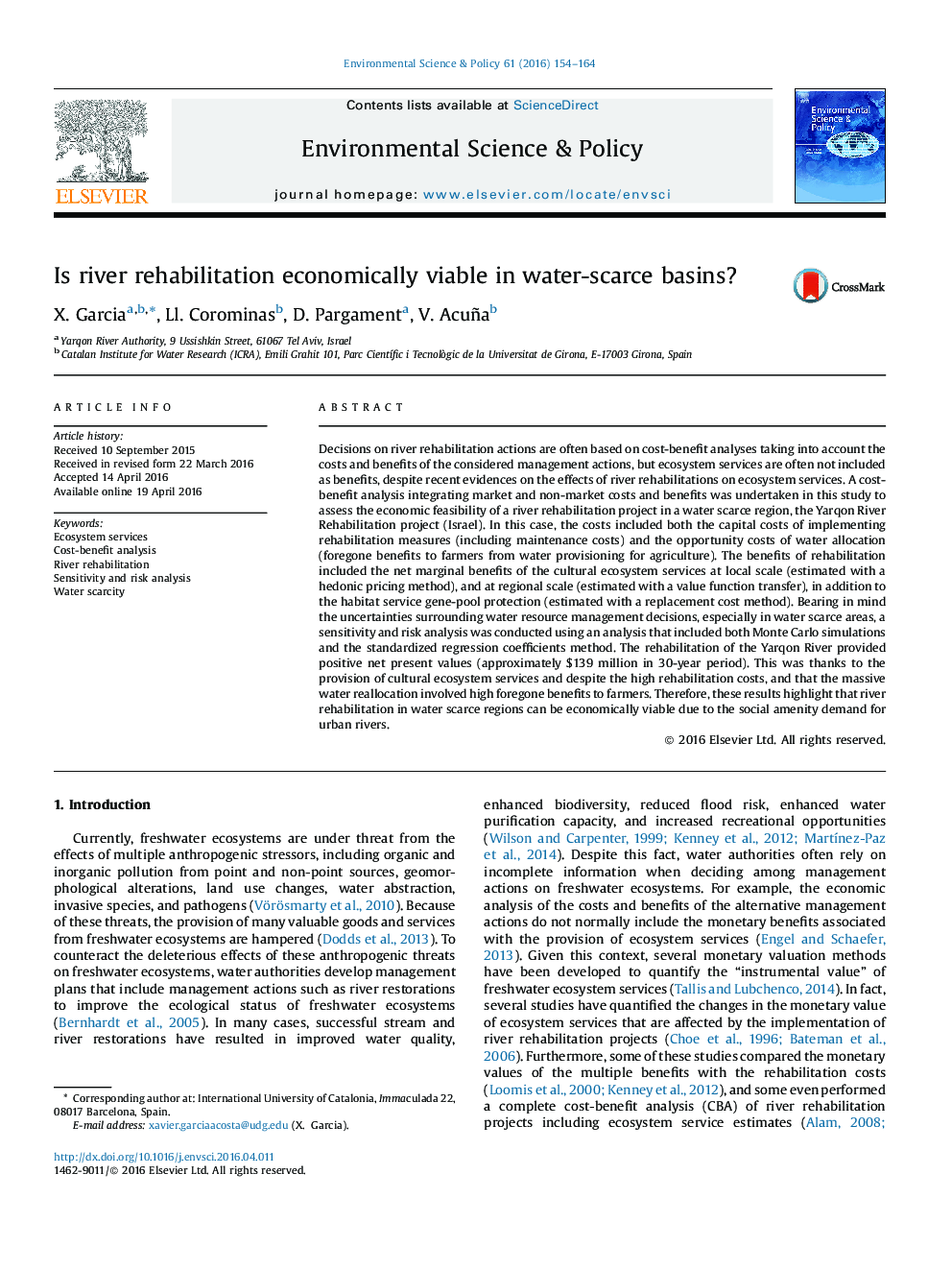| کد مقاله | کد نشریه | سال انتشار | مقاله انگلیسی | نسخه تمام متن |
|---|---|---|---|---|
| 7466875 | 1485047 | 2016 | 11 صفحه PDF | دانلود رایگان |
عنوان انگلیسی مقاله ISI
Is river rehabilitation economically viable in water-scarce basins?
ترجمه فارسی عنوان
آیا توانبخشی رودخانه از لحاظ اقتصادی در حوضچه های کم آب بسیار قابل قبول است؟
دانلود مقاله + سفارش ترجمه
دانلود مقاله ISI انگلیسی
رایگان برای ایرانیان
کلمات کلیدی
خدمات محیط زیستی، تجزیه و تحلیل هزینه و سود، توانبخشی رودخانه، حساسیت و تحلیل ریسک، کمبود آب،
ترجمه چکیده
تصمیم گیری در مورد اقدامات توانبخشی رودخانه اغلب بر اساس تجزیه و تحلیل هزینه-سود با توجه به هزینه ها و مزایای اقدامات مدیریت در نظر گرفته شده است، اما خدمات اکوسیستم اغلب به عنوان مزایا به حساب نمی آیند، علی رغم شواهد اخیر در مورد اثرات بازسازی رودخانه ها بر روی خدمات اکوسیستم. تجزیه و تحلیل هزینه-سود، یکپارچه سازی هزینه ها و مزایای بازار و غیر بازار در این مطالعه برای ارزیابی امکان سنجی اقتصادی پروژه بازسازی رودخانه در ناحیه کم آب، پروژه بازسازی رودخانه یارقون (اسرائیل) انجام شد. در این مورد، هزینه شامل هزینه های سرمایه ای برای اجرای اقدامات توانبخشی (از جمله هزینه های نگهداری) و هزینه های فرصت های تخصیص آب (مزایای مزبور به کشاورزان از تامین آب برای کشاورزی). مزایای توانبخشی شامل مزایای خالص خالص خدمات اکوسیستمی فرهنگی در مقیاس محلی (برآورد شده با روش قیمت گذاری هودینی) و در مقیاس منطقه ای (برآورد شده با یک تابع انتقال ارزش) علاوه بر حفاظت از محیط زیست خدمات زیستگاه ( با روش هزینه جایگزین تخمین زده می شود). با در نظر گرفتن عدم اطمینان در مورد تصمیمات مدیریت منابع آب، به ویژه در مناطق کمبود آب، یک حساسیت و تحلیل ریسک با استفاده از یک تحلیل که شامل هر دو شبیه سازی مونت کارلو و روش ضریب رگرسیون استاندارد شده بود انجام شد. بازسازی رودخانه یارقون ارزش فعلی خالص مثبت (حدود 139 میلیون دلار در دوره 30 ساله) را فراهم کرد. این به لطف ارائه خدمات اکوسیستمی فرهنگی و علیرغم هزینه های توانبخشی بالایی بود و این که مجددا استفاده گسترده از آب، مزایای زیادی را برای کشاورزان به ارمغان آورد. بنابراین، این نتایج نشان می دهد که توانمندسازی رودخانه ها در مناطق ضعیف آب می تواند به لحاظ اقتصادی تقاضا برای اقامتگاه های شهری قابل قبول باشد.
موضوعات مرتبط
مهندسی و علوم پایه
مهندسی انرژی
انرژی های تجدید پذیر، توسعه پایدار و محیط زیست
چکیده انگلیسی
Decisions on river rehabilitation actions are often based on cost-benefit analyses taking into account the costs and benefits of the considered management actions, but ecosystem services are often not included as benefits, despite recent evidences on the effects of river rehabilitations on ecosystem services. A cost-benefit analysis integrating market and non-market costs and benefits was undertaken in this study to assess the economic feasibility of a river rehabilitation project in a water scarce region, the Yarqon River Rehabilitation project (Israel). In this case, the costs included both the capital costs of implementing rehabilitation measures (including maintenance costs) and the opportunity costs of water allocation (foregone benefits to farmers from water provisioning for agriculture). The benefits of rehabilitation included the net marginal benefits of the cultural ecosystem services at local scale (estimated with a hedonic pricing method), and at regional scale (estimated with a value function transfer), in addition to the habitat service gene-pool protection (estimated with a replacement cost method). Bearing in mind the uncertainties surrounding water resource management decisions, especially in water scarce areas, a sensitivity and risk analysis was conducted using an analysis that included both Monte Carlo simulations and the standardized regression coefficients method. The rehabilitation of the Yarqon River provided positive net present values (approximately $139 million in 30-year period). This was thanks to the provision of cultural ecosystem services and despite the high rehabilitation costs, and that the massive water reallocation involved high foregone benefits to farmers. Therefore, these results highlight that river rehabilitation in water scarce regions can be economically viable due to the social amenity demand for urban rivers.
ناشر
Database: Elsevier - ScienceDirect (ساینس دایرکت)
Journal: Environmental Science & Policy - Volume 61, July 2016, Pages 154-164
Journal: Environmental Science & Policy - Volume 61, July 2016, Pages 154-164
نویسندگان
X. Garcia, Ll. Corominas, D. Pargament, V. Acuña,
